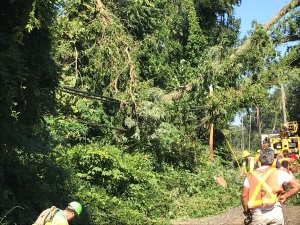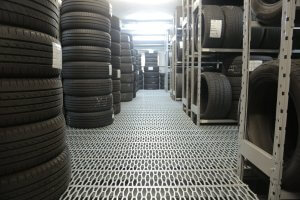Recent UTC projects from Rutgers CAIT address critical issues of asset management, transportation safety, and infrastructure resilience during severe weather events as Hurricane Season 2020 continues.

As Tropical Storm Isaias brought rain and high winds to the area, LIRR crews worked to remove downed trees on tracks across the system. Photo ©Metropolitan Transportation Authority.
Hurricane Season is upon us. And, New Jersey has been no stranger to its share of storms this year, as Tropical Storm Isaias ripped through the Northeast region earlier this summer, leaving behind destruction and power outages across the state.
Officials ranked the tropical storm among New Jersey’s top five ever in terms of destruction and power outages, according to NJ.com. It was estimated that more than 1.4 million homes and businesses lost power, and more than 575,000 PSE&G customers lost power during Isaias—comparable to the more than 2 million during Hurricane Sandy and nearly 872,000 during Hurricane Irene.
During Hurricane Season, it is as important now as ever to ensure that our transportation infrastructure—which is vital to the movement of not only goods but also people—is prepared for storms, extreme weather events, and potential natural disasters.
Some new and past University Transportation Center (UTC) research projects at the Rutgers Center for Advanced Infrastructure and Transportation (CAIT) are working to address these problems.
Transportation Resilience Virtual Peer Exchange
Improving the resilience of transportation infrastructure and operations to extreme weather events, natural disasters, and other disruptions is an important focus of transportation agencies nationwide. In addition, over the past decade, many agencies have expanded resilience efforts to include preparing for and adapting to the potential impacts of climate change. On August 17, 2020, nearly 100 transportation planning professionals from around the U.S. participated in a UTC-sponsored virtual peer exchange workshop.
The workshop included presentations from a range of transportation resilience experts and a facilitated group discussion designed to explore how agencies are organized to address resilience issues and how they are prioritizing resilience as part of capital project planning, design, and implementation. Presentations showcased leading practices and lessons learned related to: vulnerability assessment approaches, asset management methodologies, project identification and prioritization, and project design and construction.
Panelists included representatives from Port of Long Beach, CA; Southeastern Pennsylvania Transportation Authority (SEPTA); Port Authority of New York and New Jersey; Federal Highway Administration; and New York City Transit. The peer exchange workshop was organized by CAIT-affiliated researcher, Mr. Jon A. Carnegie, executive director of the Alan M. Voorhees Transportation at Rutgers.
NJDOT Flood Risk Visualization Tool
A newer UTC project at CAIT, the “NJDOT Flood Risk Visualization Tool,” aims to develop a new tool that can enhance capacity for NJDOT personnel to assess the flood vulnerability of its infrastructure and assets.
Led by Mr. Carnegie, who is also a CAIT-affiliated researcher, the project includes development of tools and workflows designed to better inform NJDOT project development and asset management decisions as well as maintenance and operations procedures.
The tool will enable NJDOT to integrate data and information about current and future flood hazard vulnerability into existing capital planning and asset management processes. Over time, the intent is to improve the overall durability and resilience of transportation infrastructure to weather and climate hazards, he said.
“New Jersey’s transportation system is vulnerable to a range of extreme weather and climate-related hazards,” Mr. Carnegie said. “Through this research we hope to provide a resource that can better inform NJDOT decisions—protecting against the potentially severe and costly impacts of extreme weather events and changing climate conditions on transportation infrastructure.”
Hydroplaning Risk of Cars and Trucks
A past UTC project led by Dr. Hao Wang, an associate professor of civil and environmental engineering and CAIT-affiliated researcher, looked at the hydroplaning risk of cars and trucks on highways.
The risk of hydroplaning is a major safety concern during rainy weather conditions for drivers and highway agencies, Dr. Wang said. That said, most studies have only focused on passenger car tires when it comes to the issue of hydroplaning, or sliding uncontrollably on wet road surfaces most prevalent during wet or snowy weather.
Limited research had gone into truck tires and hydroplaning, which inspired the “Prediction of Hydroplaning Risk of Truck on Roadways” project. The study investigated hydroplaning risk of truck tires and compared hydroplaning speeds of different tire configurations using fluid-structure interaction models. The results are also published in International Journal of Pavement Engineering.
The research showed that the new generation of single wide-base 445 tire provided better safety performance than the old wide-base 425 tire and dual tire assembly with 11R22.5 tire under wet weather conditions.

Stacks of rubber tires. Photo ©Pexels.
Other findings included increased hydroplaning potential with the increase of water film thickness on pavement surface, Dr. Wang said. On the other hand, the high wheel load or high tire inflation pressure positively increases hydroplaning speed, among other results. These findings are useful for transportation agencies to set warning signs and vehicle drivers to adjust speed control during rainy conditions.
More recently, Dr. Wang has continued this line of study with collaborators through a paper building on past UTC work titled “Optimization of tire tread pattern based on flow characteristics to improve hydroplaning resistance.” It was published this summer in the Proceedings of the Institution of Mechanical Engineers Part D Journal of Automobile Engineering.
“Hydroplaning can be very dangerous, and one element to understanding why it happens is through tire tread patterns,” Dr. Wang said. “From this study we found results that indicated optimized lateral grooves can improve tire safety in these circumstances—proving the applicability of using computational modeling and optimization solutions to guide the complex design of tire tread patterns that can benefit the tire industry.”

